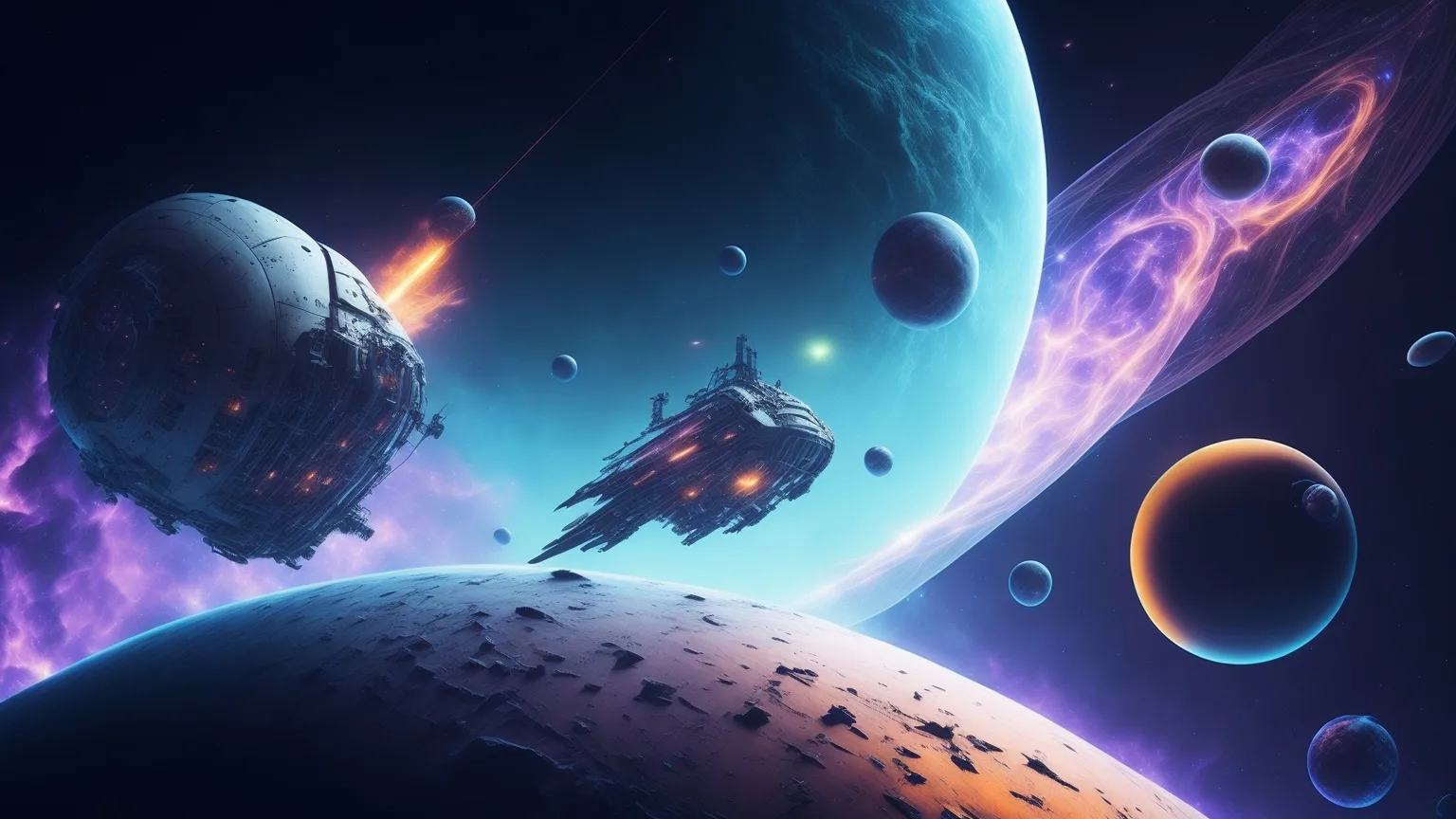Ever found yourself staring up at the night sky and wondering—how do scientists keep track of all those satellites zipping around up there? Or maybe you’ve heard about Mars rovers acting “on their own” but didn’t quite get what that means. If so, welcome to the club! With thousands of satellites in orbit and missions venturing further from home than ever before, old-school methods just can’t keep up with today’s cosmic pace.
Artificial Intelligence (AI) is changing everything we know about space exploration—no longer just a buzzword or movie plot twist. Today’s AI space research isn’t about replacing astronauts; it’s more about giving them—and our tech—a serious brain boost. We’re talking smarter satellites dodging debris, robots cruising Martian valleys without waiting for Earth’s OK, and algorithms scanning mountains of galactic data faster than any team of human researchers ever could.
Let’s dig into some real-life stories (yes, including a certain Mars rover with laser vision), surprising facts, and future-forward trends shaping this new era. Whether you’re fascinated by deep space or just want to know how AI might help save Earth from falling junk in orbit, you’re in the right place.
Key Applications And Real-World Examples Of AI Space Research
- Autonomous Rovers & Craft: Ever tried parallel parking with someone shouting instructions? Now imagine piloting a robot on Mars…with a 20-minute delay between messages! That’s why NASA packed its Perseverance rover with AI algorithms capable of making decisions on-the-fly—like swerving past big rocks or choosing which Martian boulder deserves a blast from its chemical-zapping laser. This lets science happen faster while reducing risk for these pricey machines.
- Smart Satellite Management: It’s getting crowded up there! Companies such as LeoLabs harness AI to track orbital debris and warn satellites when to dodge an incoming object—think Waze for outer space traffic jams. Other teams use machine learning to optimize how satellites consume power or extend their operational life far beyond factory predictions.
- Sifting Through Data Galaxies: Modern telescopes churn out massive streams of images every day—the digital equivalent of looking for one needle across dozens of haystacks floating through hyperspace. Here’s where smart algorithms shine: they spot exoplanets hidden behind stars’ glare, classify distant galaxies by shape, or catch fleeting events like supernovae explosions—all before your morning coffee finishes brewing.
- Mission Planning Magic: Gone are days when plotting spacecraft routes meant endless whiteboard scribbles. Today’s mission planners run thousands of scenarios using neural networks that simulate risks and rewards—for example, finding the most fuel-efficient flight path to Jupiter or orchestrating hundreds of mini-satellites shifting positions dynamically as needs change.
- Astronaut Health & Life Support: In deep space nobody wants surprise hiccups—or worse—in your life support system. That’s why closed-loop systems are getting an upgrade via onboard AIs tracking air quality, recycling water supplies more efficiently than humans ever could (or would want to).
What ties these innovations together? Smarter tools mean fewer mistakes—and way less time lost waiting for answers from Mission Control.
Quick Comparison: How AI Powers Different Parts Of Space Exploration
| Application Area | Traditional Approach | With Artificial Intelligence |
|---|---|---|
| Rover Navigation | Pilot guidance via delayed commands; slow response times during emergencies. | Real-time obstacle detection; self-directed route planning; autonomous hazard avoidance. |
| Satellite Operations | manual trajectory calculations; reactive collision responses; | Predictive analytics flag dangers ahead; dynamic resource allocation extends lifespan. |
| Astronomical Data Analysis | Cumbersome human review; long lag times between discovery & publication. | Pattern recognition at scale; automatic detection/notification accelerates discoveries. |
| Life Support Monitoring | Semi-automated checks; manual troubleshooting prone to error. | Sensors + AI predict failures early; continuous optimization ensures safety & comfort for crew. |
| Mission Planning & Design | Tedious modeling by hand/legacy software tools only test limited scenarios. | Simulates many possible outcomes fast; identifies optimal strategies given constraints. |
The Big Picture For Everyday Folks And Industry Leaders Alike
If you’ve ever felt overwhelmed by “rocket science,” you’re not alone—but here’s something relatable: think about modern GPS apps rerouting your car away from highway crashes in real time thanks to live traffic updates. Now crank that up several notches—that same magic powers everything from safer weather satellites monitoring climate change to robotic explorers rolling across alien worlds.
So whether you’re reading this over breakfast or brainstorming your next startup idea after hours at the lab, remember: AI space research isn’t confined to sci-fi movies anymore—it shapes our daily lives back on Earth too.
For more specific technical details straight from top sources—including recent advances highlighted by organizations like NASA JPL—you can always check out official releases (search “Perseverance rover AI navigation” on NASA’s site). But stick around if you’re curious where all this innovation goes next—I’ll walk through industry trends and real-world impacts coming up soon.
Understanding AI Space Research: Real-World Impact and Innovation
Curious why every space headline lately mentions artificial intelligence?
People are asking: Can AI really drive Mars rovers, or is it just another tech buzzword riding a rocket?
Folks want real answers about how AI is transforming what we know—and don’t know—about space.
Here’s the deal: AI in space research isn’t sci-fi anymore. It’s helping NASA steer robots across alien terrain and teaching satellites to dodge cosmic trash all by themselves.
If you picture scientists hunched over glowing screens as algorithms sift through mountains of star data, you’re spot-on. The universe throws a lot at us, but with today’s data overload, even the sharpest human minds need backup.
Whether it’s finding new exoplanets or keeping our satellites from playing bumper cars up there, AI has found its groove in orbit.
Let’s break down where this technology makes waves—from robot explorers that think for themselves to satellites learning on the fly—so you can see why everyone (from government agencies to Silicon Valley startups) is betting big on these digital brains in outer space.
Key Ways AI Is Used in Space Exploration Today
AI space research goes way beyond catchy headlines. These days, if something cool is happening off-Earth, chances are an algorithm had a hand—or at least a few lines of code—in making it happen.
The landscape looks like this:
- Autonomous Rovers and Probes: Think NASA’s Perseverance rover rolling across Mars. It’s not waiting for instructions—it uses machine vision to spot rocks worth zapping with lasers for chemical analysis and plots its own routes through tricky landscapes.
- Smart Satellite Operations: With thousands of satellites circling Earth, traffic control matters. Companies like LeoLabs tap into AI to predict collisions before they become multi-million-dollar headaches. These systems even help save power so satellites last longer.
- Heavy-Duty Data Crunching: Space missions generate enough raw info to make your laptop sweat bullets. Enter neural networks that find patterns humans would miss—like new planets hiding in telescope images or subtle weather shifts in Earth observation data.
- Mission Planning Magic: Launching spacecraft isn’t just aiming high—it’s optimizing routes, fuel use, and timing. By simulating countless “what if” scenarios using advanced algorithms, mission planners squeeze more science out of every launch dollar.
- Astronaut Health Monitoring: Long trips mean no quick trips home for checkups. Smart systems keep tabs on crew health and manage life support by recycling air and water efficiently—a literal lifesaver when resupply rockets aren’t coming any time soon.
This isn’t just theory; it’s how day-to-day operations run now—from Mars walks to satellite selfies beamed back from orbit.
The Numbers Behind the Trend: Growth of AI Space Research
Nobody puts money behind hype forever—so let’s talk stats.
The global market for artificial intelligence in space applications is expected to grow faster than a Saturn V launch over the next several years—industry watchers predict compound annual growth rates north of twenty percent.
It gets better: Venture capitalists love an audacious idea, especially one involving rockets and robots. In recent years their funding has flowed steadily into young companies developing autonomous navigation tools or smart debris tracking solutions.
Not surprisingly, governments are keen too. Agencies like NASA and ESA have increased their investment in building smarter missions with deep-learning smarts under the hood.
And here’s something practical—the job market reflects these priorities! Demand keeps rising for pros who get both aerospace mechanics and code wrangling.
It all signals one thing: This field isn’t cooling off anytime soon; if anything, expect liftoff as more public-private partnerships form around orbital innovation powered by artificial intelligence.
Tales From The Frontier: Success Stories That Changed the Game
Stories bring tech trends down to Earth—even if they start lightyears away!
SpaceX made headlines by landing Falcon rockets autonomously thanks largely to real-time decision-making software (think flying pencil balancing itself during touchdown).
Another win comes from satellite image analysts using computer vision models—they’re spotting illegal deforestation on Earth faster than ever before and providing early warning about melting ice caps from orbiting eyes-in-the-sky.
And let’s not forget Google teaming up with astronomers—their machine learning toolkit recently helped identify gravitational lenses hidden among millions of galaxy snapshots…finding those cosmic magnifying glasses used to take months; now it’s hours or less!
These cases aren’t just PR gold—they highlight how much faster discoveries come when humans team up with smart machines instead of wrestling mountains of raw numbers alone.
The Roadblocks No One Likes To Talk About In AI Space Research
For every breakthrough headline, there are hard problems lurking backstage—just ask anyone who codes software destined for zero-gravity hardware!
First up? Data challenges abound—not all information captured in deep space arrives cleanly packaged or easy to access due to transmission limits or old formats stuck on aging probes.
Add limited processing muscle aboard tiny spacecraft (no room for supercomputers), plus relentless cosmic radiation that fries regular chips like marshmallows near a campfire.
Now stir in transparency issues: If mission-critical AIs call shots mid-flight (“Should I fire thrusters?”), researchers must explain those choices clearly—that means extra work designing algorithms people actually trust.
And finally…ethics matter! As AIs gain independence handling costly hardware far from home turf—or making choices affecting astronaut safety—we’ll need ongoing debates about responsible design.
In short? The final frontier has its share of bug reports alongside bold visions!
The Future Vision For Smarter Missions And Human-AI Collaboration In Orbit
So what does tomorrow look like?
Picture spacecraft running lean edge-computing setups right onboard—processing signals fast enough for real-time action without calling home first.
Or imagine dozens of missions sharing lessons via federated learning; each probe gets wiser without exposing sensitive raw data.
We’ll see more advanced robotics tackling assembly jobs beyond Earth—or fixing broken equipment miles above ground so astronauts stay safer inside their pressurized cocoons.
There will also be tighter teamwork between crew members and digital assistants who analyze medical scans mid-mission or flag risks long before alarms blare.
AI won’t replace curious minds exploring stars—but together they’ll write bolder chapters as humanity pushes deeper into uncharted territory.
Ready or not—the future promises plenty more stories starring clever code alongside classic rocket fuel adventures!
The Key Players Fueling The Boom In Artificial Intelligence For Space Discovery
Nobody builds galactic empires alone—which explains why familiar names keep popping up wherever serious progress happens:
NASA leads with iconic rover missions,
ESA backs earth-watching projects,
SpaceX rewrites playbooks on rocket automation,
Leolabs hustles on orbital safety,
Lockheed Martin brings heavyweight engineering,
Google flexes search-and-analyze might,
and DeepMind experiments with novel ways algorithms learn…
Rounding out this ecosystem are energetic startups laser-focused on niche ideas—from smarter comm relays to microgravity health monitoring platforms—all chasing a piece of tomorrow’s sky-high opportunity pie!
With talent pouring into labs worldwide—and industry titans bankrolling ambitious bets—it feels safe saying the golden age for AI-powered exploration has only begun its countdown.
Real Questions Around AI Space Research
Ever wonder how a rover on Mars figures out which rock to zap next? Or how satellites dodge cosmic traffic jams without someone at NASA sweating over every move? Here’s what keeps folks up at night: “Can AI actually run a spaceship better than a human?” “Is all this data from space just piling up in some digital closet, or is there a way to make sense of it?” And maybe the big one—“Is AI in space research going to change the game for humanity, or just create more technical headaches?”
Let’s get right into why this matters. Space isn’t forgiving. The stakes are high, and communication lags between Earth and Mars can mean disaster if you wait for instructions. But AI steps in like that friend who always has an answer before you finish your sentence. From real-time problem solving on spacecraft, powering autonomous rovers that scout uncharted planets, to untangling mountains of satellite images—it’s clear: AI isn’t just another buzzword; it’s rewriting the playbook for space exploration.
Key Applications of AI Space Research Making Headlines
The best stories in tech usually start with something wild: Imagine sending a machine millions of miles away and trusting it not only to survive but to figure things out on its own. That’s where we’re at with Perseverance—the Mars rover running advanced algorithms so it doesn’t need constant hand-holding from mission control.
- Autonomous navigation: No joystick required—AI lets rovers scope out terrain, avoid danger zones, and zero in on interesting rocks without waiting hours for human input.
- Satellite self-management: Companies like LeoLabs use clever algorithms to keep satellites safe from debris—kind of like cosmic air traffic control with none of the drama.
- Crunching massive data: There are terabytes pouring down from telescopes and Earth observation satellites daily. Machine learning sifts through it all to spot supernovae, new exoplanets, or even subtle shifts in our planet’s climate.
- Lifesaving support: On long-haul missions (think months—or years—in deep space), closed-loop systems monitored by AI handle everything from water recycling to astronaut health checks so nobody runs dry or gets left behind medically.
SpaceX landing rockets almost feels routine now—but only because their guidance systems learn with every flight. And don’t forget about image analysis: Google’s using neural nets to detect gravitational lenses—little clues hiding dark matter secrets right under our noses.
Pushing Boundaries: Growth Stats and Market Trends in AI Space Research
Here’s the scoop that would perk up any investor’s ears: The whole market around AI-driven space projects is ballooning fast—annual growth rates north of twenty percent aren’t rare anymore.
Funding rounds aimed squarely at startups blending code with rocket science have doubled lately; everyone wants a piece—from government agencies (NASA throwing bigger chunks at smart automation) down to VC firms hunting the next breakthrough.
If you’ve got chops in both aerospace engineering and artificial intelligence? You’re golden right now. Employers are scrambling for people who can build hardware tough enough for radiation—and smart enough not to fry under pressure.
Battling Challenges While Chasing Progress With AI In Space
It sounds great until you hit reality checks—a few hurdles stand tall:
- Noisy data issues: Sure, we collect tons from missions—but sometimes quality takes a back seat when signals get garbled across light-years.
- Tight hardware constraints: Try running heavy-duty models on power-strapped gear built for weightlessness; it makes your laptop feel like a supercomputer by comparison.
- The trust factor: In critical roles (say guiding astronauts’ life support), people want transparency—not black box decision-making they can’t explain after something goes sideways.
- Tough environments: Cosmic rays mess with circuitry; software needs hardening just as much as steel plating outside the ship.
The Future Looks Bold For AI-Driven Space Research
Tomorrow’s hot trends sound straight-up sci-fi today:
Edge computing will push decisions right onto spaceships instead of bouncing everything back home first.
Imagine federated learning letting different probes teach each other while spread across solar systems—that means smarter robots everywhere, faster discoveries here.
Robots powered by advanced algorithms could soon be assembling habitats or patching satellites mid-orbit—with humans directing traffic rather than turning wrenches themselves.
And let’s not forget closer teamwork between astronauts and their digital copilots—turning intuition plus raw number-crunching into humanity’s best shot yet at tackling unknown worlds.
Main Players Shaping The Next Chapter Of Space Innovation
Naturally, NASA leads much of this charge alongside ESA (that’s Europe keeping pace). Private outfits step up too—SpaceX (autonomous landings anyone?), Lockheed Martin (always pushing aerospace boundaries), DeepMind tossing brainpower into orbital analytics…even Google flexes ML muscle tracking universe-defining phenomena.
Don’t overlook nimble startups breaking ground on collision avoidance software or satellite optimization tools either—the list keeps growing as fast as launch schedules fill up.
The Takeaway On Where We Go Next With Smart Machines Beyond Earth
This whole movement isn’t just cool headlines—it changes what we think is possible off-world. When machines navigate alien landscapes solo or crunch galaxies worth of photos overnight—they’re freeing humans up for bolder missions.
Will there be bumps along this ride? Absolutely—but breakthroughs never come easy. If you’re eyeing future careers or hungry for investment opportunities tied into deep tech frontiers, keep watching where machine smarts meet cosmic ambition.
After all, tomorrow might belong less to rocket scientists working alone—and more to teams pairing gutsy engineers with relentless AIs ready for anything space throws their way.
That shift is happening now…and trust me—you’ll want front row seats as history unfolds.
#AIspaceresearch #SpaceInnovation #TechFuture







